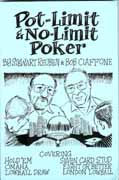
Pot-Limit and No-Limit Poker

All-In Hold'em Odds With Slick
The hold'em hand A-K is often referred to by its nickname, “big slick” (or just “slick”). I have derided the hand, in a column written a long time ago, by calling slick Bob Ciaffone is one of America’s best-known poker players, writers, and teachers. He has numerous poker tournament wins and placings, the most prominent being third place in the 1987 World Championship. He has been a poker teacher since 1995, with his students having earned well over a million dollars in tournament play. Bob's website is www.pokercoach.us its other nickname, “Walkin’ Back to Houston,” which it got from no-limit hold’em money gamblers. But in my previous column, I pointed out that it is the workhorse of tournament no-limit hold’em, as only two hands (A-A and K-K) put it in trouble. Both appellations for slick are deserved, and demonstrate the great gulf between playing with a high blind structure relative to your stack (typical tournament play) and a low blind structure relative to your stack (typical money play). In this column, I will address only tournament play.
Bob Ciaffone is one of America’s best-known poker players, writers, and teachers. He has numerous poker tournament wins and placings, the most prominent being third place in the 1987 World Championship. He has been a poker teacher since 1995, with his students having earned well over a million dollars in tournament play. Bob's website is www.pokercoach.us its other nickname, “Walkin’ Back to Houston,” which it got from no-limit hold’em money gamblers. But in my previous column, I pointed out that it is the workhorse of tournament no-limit hold’em, as only two hands (A-A and K-K) put it in trouble. Both appellations for slick are deserved, and demonstrate the great gulf between playing with a high blind structure relative to your stack (typical tournament play) and a low blind structure relative to your stack (typical money play). In this column, I will address only tournament play.
If the advantage of slick is that few hands put it in trouble, the disadvantage is that the only hands it is a really big favorite against are those with an ace or a king in them (the dominated hands). Let’s look at slick against some weak hands.
Suited Connectors: A matchup of the A K
K against the 7
against the 7 6
6 shows slick to be only a 57.3-to-42.3 favorite. Perhaps this is a surprise to many of you (it was to me when I first discovered this), because we tend to think, “All slick has to do is pair and the weaker hand needs a big hit to win, and even without pairing, slick should win lots of times.” However, the weaker hand makes some hands that beat one pair more often than you would think. And if no ace or king comes on the board, that means the connectors are working with an 11-card deck instead of the normal 13. The result is that putting your money all in — with a small stack — and running into slick is detrimental, but it need not be viewed as a big disaster. After figuring in the dead money that may be in the pot from one or both blinds, you have erred only by a small amount. And, of course, you did not know you were getting called.
shows slick to be only a 57.3-to-42.3 favorite. Perhaps this is a surprise to many of you (it was to me when I first discovered this), because we tend to think, “All slick has to do is pair and the weaker hand needs a big hit to win, and even without pairing, slick should win lots of times.” However, the weaker hand makes some hands that beat one pair more often than you would think. And if no ace or king comes on the board, that means the connectors are working with an 11-card deck instead of the normal 13. The result is that putting your money all in — with a small stack — and running into slick is detrimental, but it need not be viewed as a big disaster. After figuring in the dead money that may be in the pot from one or both blinds, you have erred only by a small amount. And, of course, you did not know you were getting called.
Unsuited Connectors: Suppose that in our previous example, the connectors were unsuited. How does this affect the odds? We are already aware that the weaker hand is distinctly better off being suited by looking at other all-in situations. In the matchup of A-K against the 7 6
6 , slick is a 61.4-to-38.6 favorite. This is only slightly worse than 3-to-2 against for the connectors; it’s unpleasant, but far from a burial.
, slick is a 61.4-to-38.6 favorite. This is only slightly worse than 3-to-2 against for the connectors; it’s unpleasant, but far from a burial.
Garbage: Here is how slick does against the worst poker hands. We will again use the A K
K . Against the 7
. Against the 7 2
2 (note that the weaker hand cannot win by making a flush), slick is a 68-to-32 favorite. Against the 3
(note that the weaker hand cannot win by making a flush), slick is a 68-to-32 favorite. Against the 3 2
2 , slick is only a 66-to-34 favorite. (The 3-2 can make many more straights than the 7-2.) Against the J
, slick is only a 66-to-34 favorite. (The 3-2 can make many more straights than the 7-2.) Against the J 5
5 , slick is a 67.5-to-32.5 favorite. Give the weaker hand some flushes to draw to by changing it to the J
, slick is a 67.5-to-32.5 favorite. Give the weaker hand some flushes to draw to by changing it to the J 5
5 , and the odds drop slightly, to 66.8-to-33.2.
, and the odds drop slightly, to 66.8-to-33.2.
Here is the upshot of our discussion. Slick is used here to show that even when you have garbage or close to it, running into a call is not a huge disaster unless the opponent has a hand that dominates yours, or an overpair. If you go all in with trash like 7-4, you are really unlucky if you get called by a hand that has one of your cards. About the only way that happens is if your opponent has an ace and a precise card with it that pairs one of yours (and even with that hand, maybe he won’t call). It is also unlikely that you will run into a pair, when there are only one or two hands to get through. Not all pairs are toxic opponents; threes or deuces may not call, and it will not be a disaster if they do.
So, let’s see what happens when you have a weak hand on the button with $500 in your stack, the blinds are $50-$100, and everyone folds to you. The odds of running into a pocket pair in the big blind are about 17-to-1 against. The odds on either one of the blinds having a pocket pair are about 9-to-1 against. So far, so good. Furthermore, when you have a piece of junk, you are most unlikely to run into a dominating hand. (If your opponent had one of your cards, and his other card was anything but an ace, he would almost surely fold.) So, when you do get called, it is likely to be by a hand that has two big cards. This makes you an underdog, but you are far from being buried.
When you put all of your chips into the pot, your opponents usually give you credit for having some semblance of a hand, even when you have only a small stack and are in steal position. They are thinking small pair, rag ace, two paints, a little something. So, the fact of the matter is, putting all of your chips into the pot with pure junk will result in most of the hands that beat you being folded.
My conclusion is, when your stack is so low as to put you in desperate straits, your decision of whether to go all in is as much (or more) situational as it is dependent on your cards. If you have only a few players to get through, do not be afraid to move all in with weak hands. It’s better to hope that you do not get called than to risk dwindling down to a stack so small that getting called is a near certainty. My opinion is, when you get down to five times the big blind or less in chips, it is time to go into panic mode. Look for a good spot to steal, rather than a hand that has a decent look to it.
The odds given in this article have another application besides encouraging a short stack to be hyperaggressive. Let me give you a theoretical situation. You have the big blind of $1,000 and an extremely short stack. The small blind is a big stack and moves all in without looking at his cards. (OK, he looked at them, but you know it was only a gesture, and he was certainly going to put you all in instead of giving a desperate man a walk.) How big does the size of his raise (in other words, the size of your stack) have to be for you to look at your cards before committing your money?
If you look at the way all-in matchups measure up against each other, you can see that you are not likely to be more than a 2-to-1 dog even with a lemon like 3-2 or 7-2. So, my answer is to play in the dark unless your opponent has raised an all-in amount of more than triple your big blind, in which case looking at your hand is in order.
A frequent comment of those people who watch televised poker is, “How can they play such bad hands?” Perhaps this column will help to answer that question. Frankly, I do not understand how some of these guys can call with the trash they sometimes do, but it is easy to understand why they often bet with trash. The math of raising with trash when you have a short stack favors aggression.

